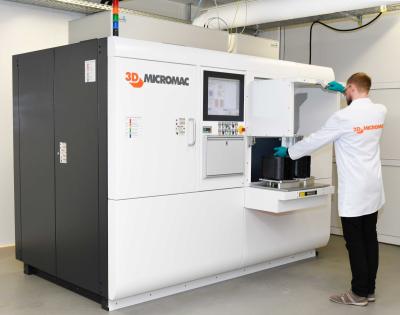We're happy to interview 3D Micromac, as part of our series of interviews with MicroLED Industry Association members. Germany-based 3D-Micromac is the industry leader in laser micromachining and roll-to-roll laser systems. The company offers laser equipment for µLED forward transfer, lift-off and repair process steps - ready for high volume production.
Hello, can you introduce your company and technology?
Frank Richter (Head of Sales at 3D Micromac): 3D-Micromac has established itself as a leader in laser micromachining and a pioneer of new production technologies for various industries for the last 20 years. This especially applies to the excimer and ultra-short pulse laser technology.
We have extensive experience applying innovative laser technology to new and emerging applications to support their volume-production requirements. For MicroLED production, ultra-high precision in combination with the highest reliability and stability is needed. These are core competencies of 3D-Micromac.
Our product portfolio includes several laser-based system solutions for various manufacturing steps in the MicroLED production process. All systems offer integrated process control and monitoring to assure stable and reliable operation, thus enabling high throughput and low yield losses.
- The microMIRA, a laser lift-off system, provides highly uniform, force-free lift-off of different layers on large-area substrates at high processing speeds without the need for costly and polluting wet chemical processes. The unique line beam system is built on a highly customizable platform that can incorporate different laser sources, wavelengths, and beam paths to meet each customer’s unique requirements. The system can process various substrate materials and sizes and achieve processing speeds (including handling) of up to 60 eight-inch wafers per hour.
- 3D-Micromac’s microCETI system enables the cost-effective transfer of MicroLED devices using the LIFT (laser-induced forward transfer) process. The high-speed process allows the transfer of hundreds of millions of MicroLEDs per hour without applying mechanical forces – up to several orders of magnitude faster than other approaches – while the on-the-fly square-beam laser enables the transfer of nearly any shape and size of MicroLED.
- The third one – our microVEGA system – provides laser-based single-die repair via trimming.
Can you say why you joined the microLED association and what it is you hope to achieve?
As said, MicroLED production processes constitute a significant focus for 3D-Micromac. However, the market is highly diverse, and no standards or best-known methods are available. To gain a broader view of the needs, challenges, and chances, we decided to join the microLED association.
What is your biggest challenge and success to date in the microLED industry?
- Currently, our systems create much interest throughout the industry as µLED is one of the current key topics. Thus, we have many talks with prospects and subsequent process demos.
- We sold several systems for all our existing processes and await more orders within the following months.
- One of the biggest challenges is adapting the MicroLED technology in the mass market beyond the available solutions for premium TVs and AR microdisplays. The manufacturing of µLED devices is a complex approach with many challenges that must be overcome.
Can you detail your latest prototype/demonstration?
microMIRA, microCETI, and microVEGA – are available for our customers with various options up to full customizing. Following the request for cost down of the overall production process, we are working on solutions for larger substrates as well as solutions to process much smaller dies.
With our all-new microPOLAR, we address the market of AR and VR devices, where precise eyepieces need to be cut out of high-index transparent materials with the lowest CAPEX.
How do you see microLEDs changing the display industry in the next 5-10 years?
There will be changes for sure, especially for wearables and small displays; however, manufacturing large and comparable cheap displays is a different story.
With the microCETI, the microMIRA, and the microVEGA, we offer solutions for crucial processes within the µLED production. Our goal is to grow our market share within the next year successfully.
Since last year, we have been working on solutions for AR/VR devices, as mentioned previously. MicroLED will significantly influence these products, even as enabling technology.

